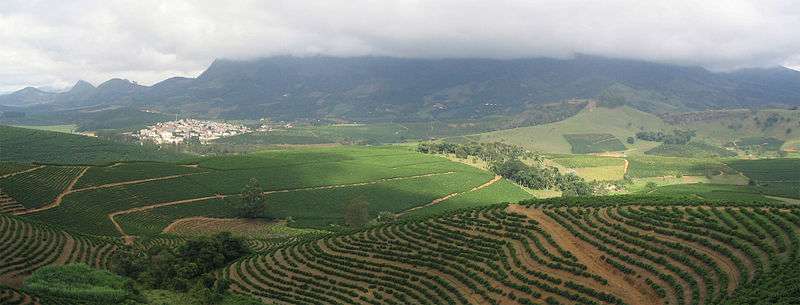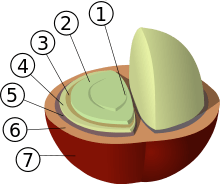Coffea arabica
| Coffea arabica | |
|---|---|
| Coffea arabica flowers | |
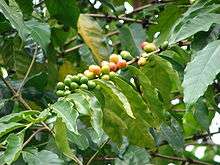 | |
| Coffea arabica fruit | |
| Scientific classification | |
| Kingdom: | Plantae |
| Clade: | Angiosperms |
| Clade: | Eudicots |
| Clade: | Asterids |
| Order: | Gentianales |
| Family: | Rubiaceae |
| Genus: | Coffea |
| Species: | C. arabica |
| Binomial name | |
| Coffea arabica | |
Coffea arabica (/əˈræbɪkə/), also known as the Arabian coffee, "coffee shrub of Arabia", "mountain coffee", or "arabica coffee", is a species of Coffea. It is believed to be the first species of coffee to be cultivated, and is the dominant cultivar, representing some 60% of global production.[1] Coffee produced from the less acidic, more bitter, and more highly caffeinated robusta bean (C. canephora) makes up the preponderance of the balance.
Biology
Wild plants grow between 9 and 12 m (30 and 39 ft) tall, and have an open branching system; the leaves are opposite, simple elliptic-ovate to oblong, 6–12 cm (2.5–4.5 in) long and 4–8 cm (1.5–3 in) broad, glossy dark green. The flowers are white, 10–15 mm in diameter and grow in axillary clusters. The seeds are contained in a drupe (commonly called a "cherry") 10–15 mm in diameter, maturing bright red to purple and typically contains two seeds, the actual coffee beans.
Coffea arabica is the only polyploid species of the genus Coffea, as it carries 4 copies of the 11 chromosomes (44 total) instead of the 2 copies of diploid species. Specifically, Coffea arabica is itself the result of a hybridization between the diploids Coffea canephora and Coffea eugenioides,[2] thus making it an allotetraploid, with two copies of two different genomes.
Distribution and habitat
Endemic to the mountainous regions of Yemen and the southwestern highlands of Ethiopia.[3] C. arabica is now rare in Ethiopia, while many populations appear to be of mixed native and planted trees. In Ethiopia, where it is called būna, it is commonly used as an understorey shrub. It has also been recovered from the Boma Plateau in South Sudan. C. arabica is also found on Mount Marsabit in northern Kenya, but it is unclear whether this is a truly native or naturalised occurrence.[4] The species is widely naturalised in areas outside its native land, in many parts of Africa, Latin America, Southeast Asia, China, and assorted islands in the Caribbean and in the Pacific.[5]
The conservation of the genetic variation of C. arabica relies on conserving healthy populations of wild coffee in the Afromontane rainforests of Ethiopia. Genetic research has shown coffee cultivation is threatening the genetic integrity of wild coffee because it exposes wild genotypes to cultivars.[6] Nearly all of the coffee that has been cultivated over the past few centuries originated with just a handful of wild plants from Ethiopia, and today the coffee growing on plantations around the world contains less than 1% of the diversity contained in the wild in Ethiopia alone.[7]
Cultivation and use
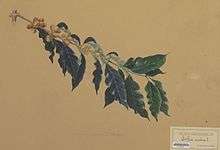

Arabica coffee's first domestication in Ethiopia is obscure, but cultivation in Yemen is well documented by the 12th century.[8]
Coffea arabica accounts for 60% of the world's coffee production.[1]
C. arabica takes approximately seven years to mature fully, and it does best with 1.0–1.5 meters (about 40–59 inches) of rain, evenly distributed throughout the year. It is usually cultivated between 1,300 and 1,500 m altitude, but there are plantations that grow it as low as sea level and as high as 2,800 m.[9]
The plant can tolerate low temperatures, but not frost, and it does best with an average temperature between 15 and 24 °C (59 and 75 °F).[10] Commercial cultivars mostly only grow to about 5 m, and are frequently trimmed as low as 2 m to facilitate harvesting. Unlike Coffea canephora, C. arabica prefers to be grown in light shade.
Two to four years after planting, C. arabica produces small, white, highly fragrant flowers. The sweet fragrance resembles the sweet smell of jasmine flowers. Flowers opening on sunny days result in the greatest numbers of berries. This can be problematic and deleterious, however, as coffee plants tend to produce too many berries; this can lead to an inferior harvest and even damage yield in the following years, as the plant will favor the ripening of berries to the detriment of its own health.
On well-kept plantations, overflowering is prevented by pruning the tree. The flowers only last a few days, leaving behind only the thick, dark-green leaves. The berries then begin to appear. These are as dark green as the foliage, until they begin to ripen, at first to yellow and then light red and finally darkening to a glossy, deep red. At this point, they are called "cherries," which fruit they then resemble, and are ready for picking.
The berries are oblong and about 1 cm long. Inferior coffee results from picking them too early or too late, so many are picked by hand to be able to better select them, as they do not all ripen at the same time. They are sometimes shaken off the tree onto mats, which means ripe and unripe berries are collected together.
The trees are difficult to cultivate and each tree can produce from 0.5 to 5.0 kg of dried beans, depending on the tree's individual character and the climate that season. The most valuable part of this cash crop are the beans inside. Each berry holds two locules containing the beans. The coffee beans are actually two seeds within the fruit; sometimes, a third seed or one seed, a peaberry, grows in the fruit at tips of the branches. These seeds are covered in two membranes; the outer one is called the "parchment coat" and the inner one is called the "silver skin."
On Java Island, trees are planted at all times of the year and are harvested year round. In parts of Brazil, however, the trees have a season and are harvested only in winter. The plants are vulnerable to damage in such poor growing conditions as cold or low pH soil, and they are also more vulnerable to pests than the C. robusta plant.[11]
Arabica coffee production in Indonesia began in 1699. Indonesian coffees, such as Sumatran and Java, are known for heavy body and low acidity. This makes them ideal for blending with the higher acidity coffees from Central America and East Africa.
In Hawaii, coffee was formerly more widely grown than at present, and it persists after cultivation in many areas. But in some valleys, it is a highly invasive weed.[12] In the Udawattakele and Gannoruwa Forest Reserves near Kandy, Sri Lanka, coffee shrubs are also a problematic invasive species.[13]
It is expected that a medium-term depletion of indigenous populations of C. arabica may occur, due to projected global warming, based on IPCC modelling.[14]
According to journalist Herbert van der Vossen, potential risks to arabica production due to climate change are being anticipated and planned for through the development of next-generation varieties. Risks to coffee arabica include a changing climate, rising temperatures, longer droughts and excessive rainfall.[15]
Gourmet coffees are almost exclusively high-quality mild varieties of arabica coffee, and among the best known arabica coffee beans in the world are those from Jamaican Blue Mountain, Colombian Supremo, Tarrazú, Costa Rica, Guatemalan Antigua, and Ethiopian Sidamo.[16][17][18] Espresso typically is made from a blend of arabica and robusta beans.
History
The first written record of coffee made from roasted coffee beans comes from Arab scholars, who wrote that it was useful in prolonging their working hours. Yemen's close proximity to Ethiopia meant that the two nations engaged in trade so it is natural that this beverage first spread to the Yemeni people from the highlands of Ethiopia.[19] It later spread first among the Turks, and later on found its way around the world. Other scholars believe that the coffee plant was introduced into Yemen from Abyssinia, based on a Yemeni tradition that slips of both coffee and qat were planted at 'Udein' ('the two twigs') in Yemen in pre-Islamic times.[20]
Taxonomy
Coffea arabica was first described by Antoine de Jussieu, who named it Jasminum arabicum after studying a specimen from the Botanic Gardens of Amsterdam. Linnaeus placed it in its own genus Coffea in 1737.[21]
Strains
One strain of Coffea arabica naturally contains very little caffeine. While beans of normal C. arabica plants contain 12 mg of caffeine per gram of dry mass, these mutants contain only 0.76 mg of caffeine per gram, but with all the taste of normal coffee.[22]
Gallery
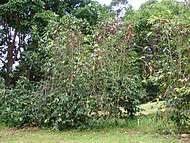
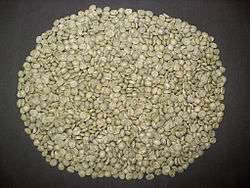 Unroasted ("green") coffee (Coffea arabica) beans from Brazil.
Unroasted ("green") coffee (Coffea arabica) beans from Brazil.
See also
![]()
References
- 1 2 "Coffee: World Markets and Trade" (PDF). United States Department of Agriculture – Foreign Agricultural Service. 16 June 2017. Retrieved 8 December 2017.
- ↑ Lashermes, P.; Combes, M.-C.; Robert, J.; Trouslot, P.; D'Hont, A.; Anthony, F.; Charrier, A. (1999-03-01). "Molecular characterisation and origin of the Coffea arabica L. genome". Molecular and General Genetics MGG. 261 (2): 259–266. doi:10.1007/s004380050965. ISSN 0026-8925.
- ↑ Martinez-Torres, Maria Elena (2006). Organic Coffee. Ohio University. ISBN 9780896802476. Retrieved 26 January 2016.
- ↑ Charrier & Berthaud (1985), p. 20.
- ↑ Kew World Checklist of Selected Plant Families, Coffea arabica
- ↑ Silvarolla, M. B.; Mazzafera, P.; Fazuoli, L. C. (2004). "Plant biochemistry: A naturally decaffeinated arabica coffee". Nature. 429 (6994): 826. doi:10.1038/429826a. PMID 15215853.
- ↑ Rosner, Hillary (October 2014). "Saving Coffee". Scientific American. 311 (4): 68–73. doi:10.1038/scientificamerican1014-68. PMID 25314878.
- ↑ Söndahl, M. R.; van der Vossen, H. A. M. (2005). "The plant: Origin, production and botany". In Illy, Andrea; Viani, Rinantonio. Espresso Coffee: The Science of Quality (Second ed.). Elsevier Academic Press. p. 21. ISBN 978-0-12-370371-2.
- ↑ Schmitt, Christine B. (2006). Montane Rainforest with Wild Coffea Arabica in the Bonga Region (SW Ethiopia): Plant Diversity, Wild Coffee Management and Implications for Conservation. Cuvillier Verlag. p. 4. ISBN 978-3-86727-043-4.
- ↑ Taye Kufa Obso (2006). Ecophysiological Diversity of Wild Arabica Coffee Populations in Ethiopia: Growth, Water Relations and Hydraulic Characteristics Along a Climatic Gradient. Cuvillier Verlag. p. 10. ISBN 978-3-86727-990-1.
- ↑ "Coffee: The World in Your Cup." Seattle, WA: Burke Museum at the University of Washington.
- ↑ "Coffea arabica (PIER species info)". Retrieved 15 July 2011.
- ↑ Nyanatusita, Bhikkhu; Dissanayake, Rajith (2013). "Udawattakele: 'A Sanctuary Destroyed From Within'" (PDF). Loris, Journal of the Wildlife and Nature Protection Society of Sri Lanka. 26 (5 & 6): 44.
- ↑ Davis, Aaron P.; Gole, Tadesse Woldemariam; Baena, Susana; Moat, Justin (2012). "The impact of climate change on indigenous arabica coffee (Coffea arabica): Predicting future trends and identifying priorities". PLoS ONE. 7 (11): e47981. doi:10.1371/journal.pone.0047981. PMC 3492365. PMID 23144840.
- ↑ van der Vossen, Herbert (2015). "Next generation variety development for sustainable production of arabica coffee (Coffea arabica L.)". Euphytica. 204 (2): 244. doi:10.1007/s10681-015-1398-z.
- ↑ "Os melhores grãos do mundo". Revista Veja (in Portuguese). Editora Abril. 31 July 2008. Archived from the original on 5 August 2008. Retrieved 29 July 2008. Edition 2071. Print edition p. 140
- ↑ Fussell, Betty (5 September 1999). "The World Before Starbucks". The New York Times. Retrieved 29 July 2008.
- ↑ Fabricant, Florence (2 September 1992). "Americans Wake Up and Smell the Coffee". The New York Times. Retrieved 29 July 2008.
- ↑ https://www.aromacoffee.ae
- ↑ Western Arabia and the Red Sea, Naval Intelligence Division, London 2005, p. 490 ISBN 0-7103-1034-X
- ↑ Charrier, A.; Berthaud, J. (1985). "Botanical Classification of Coffee". In Clifford, M. H.; Wilson, K. C. Coffee: Botany, Biochemistry and Production of Beans and Beverage. Westport, Connecticut: AVI Publishing. p. 14. ISBN 978-0-7099-0787-9.
- ↑ Silvarolla, Maria B.; Mazzafera, Paulo; Fazuoli, Luiz C. (2004). "Plant biochemistry: A naturally decaffeinated arabica coffee". Nature. 429 (6994): 826. doi:10.1038/429826a. PMID 15215853.
Further reading
- Silvarolla, Maria B.; Mazzafera, Paulo; Fazuoli, Luiz C. (2004). "A naturally decaffeinated arabica coffee". Nature. 429 (6994): 826. doi:10.1038/429826a. PMID 15215853.
- Weinberg, Bennet Alan; Bealer, Bonnie K. (2001). The World of Caffeine: The Science and Culture of the World's Most Popular Drug. New York: Routledge. ISBN 978-0-415-92722-2.
External links
- World Checklist of Rubiaceae
- Understanding the difference between Arabica and Robusta
- CoffeeResearch.org
| Wikimedia Commons has media related to Coffea arabica. |
